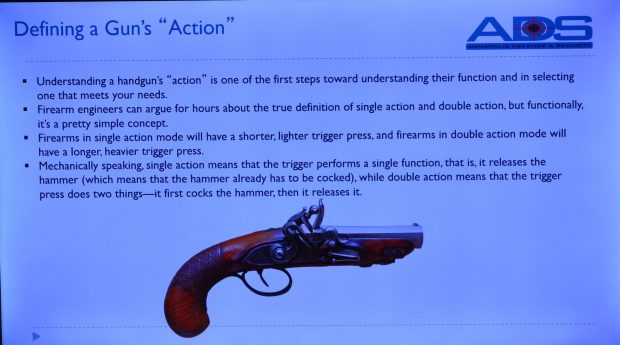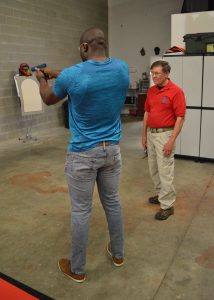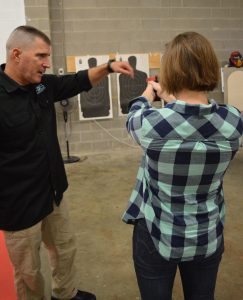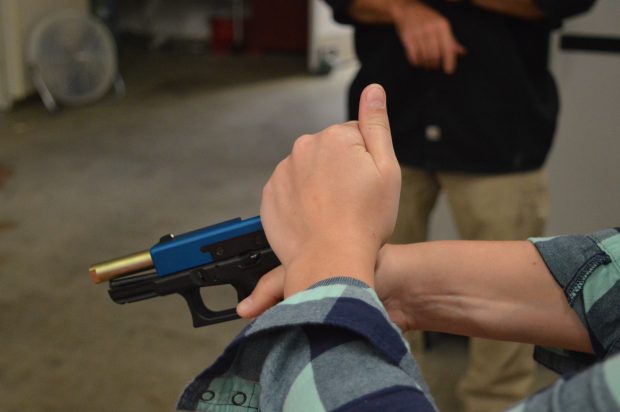Wear and Carry: Annapolis Defense aims to educate responsible gun owners
Joe Lynch of Annapolis Defense & Security instructing a class of Wear and Carry permit applicants. (Anthony C. Hayes)
ANNAPOLIS, MD — Maryland law stipulates that anyone seeking a Wear and Carry permit first complete an approved firearms training course. It’s a costly condition that gun rights advocates hope will be revised in the upcoming legislative session – even as they agree that firearms training is a common-sense provision.
But what does it take for Marylanders to meet the state concealed carry permit requirements? Does the requisite training prepare them for any gun-related contingency? Can gun owners lawfully intercede in an active shooter situation? What part should education play in any serious discussion about an individual’s right to bear arms?
These are a few questions this reporter recently asked Army veteran Joe Lynch – a certified handgun safety instructor and founder of Annapolis Defense & Security.
“We believe an individual will only perform to the best of their training,” said Lynch. “There are no stupid questions, only stupid people. And stupid people don’t train.”

Lynch said if I wanted the get the bigger picture, the best way to learn the answers would be to sit in on an upcoming class and then draw my own conclusions.
I accepted his offer and cleared a day to audit the class.
The eight-hour course began promptly at 9 a.m. the following Saturday morning. The small class size (there were only three other students) surprised me at first, given the record sales of handguns over the last few years. But that intimacy also allowed for a free flow of ideas. No question was off the table.
Joining Lynch on the dais for the morning sessions was veteran law enforcement instructor Dennis “Sarge” O’Toole. Lynch opened the class with the sobering statement, “I’m a combat veteran, and the last thing I want to do is shoot at a person again.”
The course covers firearms as a machine, Maryland firearms law and dealing with law enforcement, and a myriad of safety topics, ranging from safe storage to the Use of Force Continuum.
Students learn about the history of firearms, examine commonly held myths about guns and ammo, spend a few hours working on firearms handling, then end the class with live-fire practice and some force-on-force real-world scenarios (including the 21-foot Tueller drill.)
Lynch said the training cost for the initial issue is $225 per person and renewal is $125. Each applicant needs to get LiveScan fingerprints that average $65 a set and passport photos to go along with their permit application. Renewal does not require re-fingerprinting and only eight hours of training with the qualification course of fire.
With pen in hand, I began to take copious notes.
From Flintlocks To Glocks

Granted, no one in the class that day was considering enlisting in George Washington’s army. However, learning the history of firearms makes sense, not only from an evolutionary standpoint, but it helps with understanding how we came to be a nation and where we are as a society today.
On the table below the projector screen, Lynch had laid out a dozen or so modern handguns and magazines. A hands-on explanation of each model brought the syllabus to life.
Critical lesson number one: ALWAYS CHECK TO MAKE SURE THE FIREARM IS UNLOADED. Absent our time during the live-fire portion of the course, all firearms remained unloaded and were checked and rechecked each time a gun passed from one pair of hands to another.
“You have a good self-defense tool with a gun,” said O’Toole, “but your brain is your best weapon.”
Ballistics of the most widely used ammunition was explained in terms any layman could understand, as was an overview of gun laws pertaining to outlawed rounds. Our instructors also covered the vital importance of talking to kids about guns, the prudence of purchasing firearm insurance, and the necessity of obtaining a gun safe for both our weapons and stock of ammunition.
“What about calibre?” asked one of the students. “Isn’t a .45 more effective than a .9 mm round?”
“That’s a common myth that can be settled when we look at the joules of energy chart,” said Lynch.
Charts and graphs were supplemented by video clips featuring nationally known firearms instructor Michael Martin.

With a quick show of hands, I learned that our small class was evenly split between people applying for a Wear and Carry permit and those who currently own (or are planning to purchase) a gun for home defense. For those seeking a permit, Lynch implored, “Make sure you have a good and substantive reason to carry a firearm in public. If you have any questions about your rights, always ask a lawyer who is familiar with Maryland gun law.”
During one of our breaks, I spoke with the two students who are seeking Wear and Carry permits. They are a 20-something couple from Silver Spring.
She is a Missouri native, who said she grew up around hunters and developed a love of sport shooting at an early age. He is an Air Force recruit, who took up sport shooting a few years ago when he met his Missouri-born friend. Together, both expressed concerns about personal safety and said they wanted to stay within the boundaries of Maryland law.
Both asked that I not use their real names.
The third student (who also asked that I don’t use his name) was a Pasadena-area man in his mid-50s. He said he’d never owned a gun but is considering making a purchase.
“My kids are all grown and gone, so having a gun in the house is no longer an issue. I’ve never owned a gun, and I’m probably not your typical buyer. But I won’t lie – I’m concerned about violent crime. It’s one thing to read about murders in Baltimore City, but when you have home invasions here in Anne Arundel County? That’s why I’m taking this course.”
Avoiding ‘Nightmare Scenarios’
Owning a firearm is not without its nightmare scenarios. Some examples of this phenomena are:
My gun doesn’t work
I keep missing my target
The attacker keeps coming toward me
O’Toole said maintenance and cleaning, rotating ammunition (to always have a fresh supply on hand), practice at a range, and shot placement were keys to overcoming such dreaded scenarios.
“No one should take this course, buy a gun, and then store it in your nightstand,” explained O’Toole. “When you are done here, you will still have a lot of training to do.”
Midway through the day, each student was asked to come forward and select a handgun of their choosing. The purpose was not only to acclimate us with the various actions built into differing guns but to give a real sense of how it feels to carry a firearm on one’s belt.

(Anthony C. Hayes)
“It is important to find a gun that is a good fit,” said O’Toole. “You don’t want a gun that is too big to handle or one too small for your hand.”
Nor do you want one too weak to do the job, or one with a load too powerful to precisely control.
This reporter opted to practice with the sole single-action revolver on display – a .357 calibre Ruger Blackhawk. I’m familiar with the Ruger line, having previously trained with a single-action Ruger Vaquero.
O’Toole said picking the Blackhawk was actually a very good choice. Highly reliable single-action revolvers are recommended for home defense.
My classmates tended toward .9 mm semi-automatic weapons – mostly Berettas and Glocks. One clear advantage with these weapons is that .9 mm ammo (the NATO standard) is relatively inexpensive and easy to obtain.
Later, we would load these same weapons with non-lethal Simunition soap-projectile cartridges for the live-fire part of the course.
What Would You Do?
With gun ownership comes grave responsibility. Lynch said he carries a gun, “because I can’t fit a police officer in my holster.” His astute aside – though clearly ironic – underlined a concern many Americans have today.
“What would I do if I found myself in an active shooter situation?”
“Concealed carry permit holders should always be prepared to respond in an active shooter scenario,” said O’Toole. “You’re not the person there to enforce the law, but you may be the only person there who can stop a crime. The police may be minutes away, while you are mere seconds away.”
How exactly should one engage an active shooter?
“Shout PO-LICE three times as clearly and loudly as you can,” said O’Toole. “Active shooters will often disengage once they know someone is about to engage them. If you’re with someone, have them call 911 and tell the dispatcher that you are about to engage the active shooter. Tell your friend to be sure to describe you, too. ‘Bob Johnson is wearing a yellow shirt and blue pants. He is 40, he is bald, he has a beard, etc.’ That way, when the police arrive, they know to call you by name, what you look like, and exactly how you are dressed.
“Not everyone knows how they would react in such a life-or-death scenario. That’s sure to be a factor in the upcoming trials in the Florida school shooting case. Ultimately, for the law-abiding gun owner, it comes down to the question, ‘Can you look in the mirror and live with yourself, if you could have done something and you didn’t?’”
Moving from the classroom to the warehouse gymnasium, we practiced drawing our weapons in the Tueller drill. If you think Ray Lewis used to close quickly on opposing quarterbacks, try reacting to a knife-wielding fiend closing in behind you from 21-feet away.
Once we’d regained our composure, it was time for the live-fire exercise. Here, even the newbies did well, demonstrating their budding skills while hitting silhouettes on paper targets from varying distances.

Returning to the classroom, we were joined by Annapolis Defense & Security co-founder Aaron Herschman, who had slipped in to witness the live-fire exercises and sign the state paperwork for students completing the course.
“As you’ve seen here today, we teach basic firearms education and practical firearms skills,” explained Herschman. “Other classes may key in on questions like, ‘What’s the best gun and ammo combination for self-protection?’ And that’s fine. We talked about that but also urge students to take into account the real-world scenarios we’ve discussed. Things like, always remember to keep safety glasses and a tourniquet wherever you store your gun.
“Wood shatters and drywall bursts when hit by bullets. If you’ve got splinters or dust in your eyes, it’ll be hard to protect your family.
“As for a tourniquet, knowing how to render first aid in a gunfight is equally important. It could be the difference between life and death and how a court ultimately views your actions. Just keep in mind that in most cases, your gun is your secondary weapon. You should disengage whenever possible. A gun should not be looked at as a means to fight but as a means to escape.”
Herschman concluded the class with a grim reminder:
“If you are going to carry, please practice. Stay proficient with all of your guns. And always remember, if you have to use your weapon, you have just become responsible for all of the people within range of the bullets you are firing.”
Knowledge Begins With Experience
So, was it worth our time to invest an entire Saturday immersed in a firearms training course?
Given the wealth of information and hands-on coaching crammed into the 8-hour class, I would voice an unequivocal yes. My fellow students happily agreed.
“This would be a good class to take, even if you are not applying for a concealed carry permit,” noted the Air Force recruit from Silver Spring. “The information presented is extremely useful for any gun owner.”
I would simply add that the information presented is extremely useful for anyone – regardless of gun ownership or where one stands on the Second Amendment.
This reporter went into the class with honest questions about the licensing and use of handguns, and about fellow Marylanders who purchase guns for self-defense. Having completed the course, I now have a clearer understanding of the issues on the table – especially as they relate to the very real concerns many Americans have about crime and self-protection.
It’s one thing to talk about firearms in the safety of a social setting; quite another when you’re the one who is the potential victim of a violent crime.
On the flip side, one can well understand the state’s concern about the proliferation of guns – particularly in war zones like Baltimore City. What isn’t clear is why lawmakers continue to enact legislation that effectively disarms law-abiding citizens. As reported here earlier, obtaining a concealed carry permit can be a vexing proposition. Ask anyone who has gone through the process.
“I wish that I could afford to offer these courses for free and invite every person eligible to purchase a firearm to participate free of charge,” said Lynch. “I believe this training is vital, and we would be doing our communities a service by teaching firearms safety and responsible use in schools, right along with Health class and SexEd.”
* * * * *
Annapolis Defense & Security is located at 413 Headquarters Dr, Suite 5 Millersville, MD 21108. For scheduling and costs, look for them on the web, or by phone at 443-333-4042.

Anthony C. Hayes is an actor, author, raconteur, rapscallion and bon vivant. A one-time newsboy for the Evening Sun and professional presence at the Washington Herald, Tony’s poetry, photography, humor, and prose have also been featured in Smile, Hon, You’re in Baltimore!, Destination Maryland, Magic Octopus Magazine, Los Angeles Post-Examiner, Voice of Baltimore, SmartCEO, Alvarez Fiction, and Tales of Blood and Roses. If you notice that his work has been purloined, please let him know. As the Good Book says, “Thou shalt not steal.”
